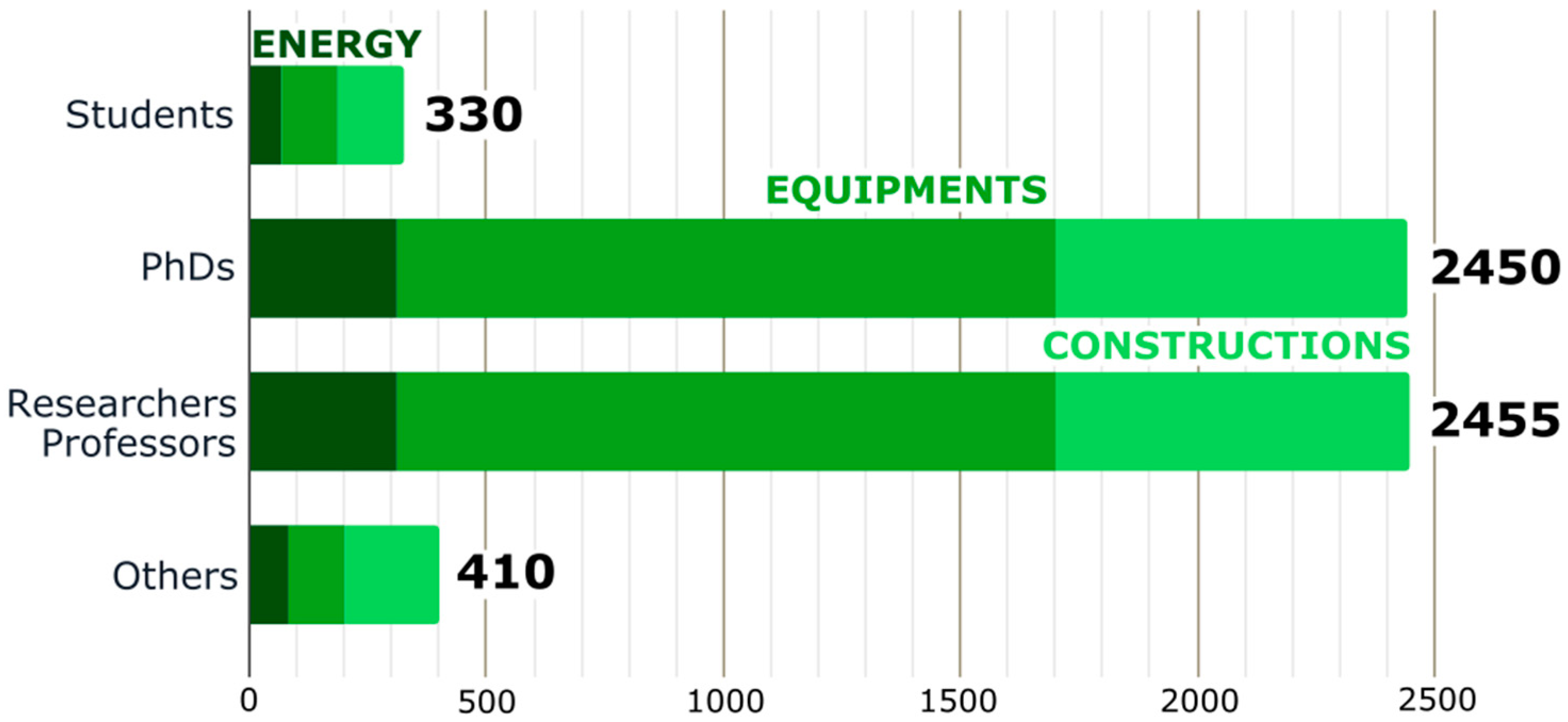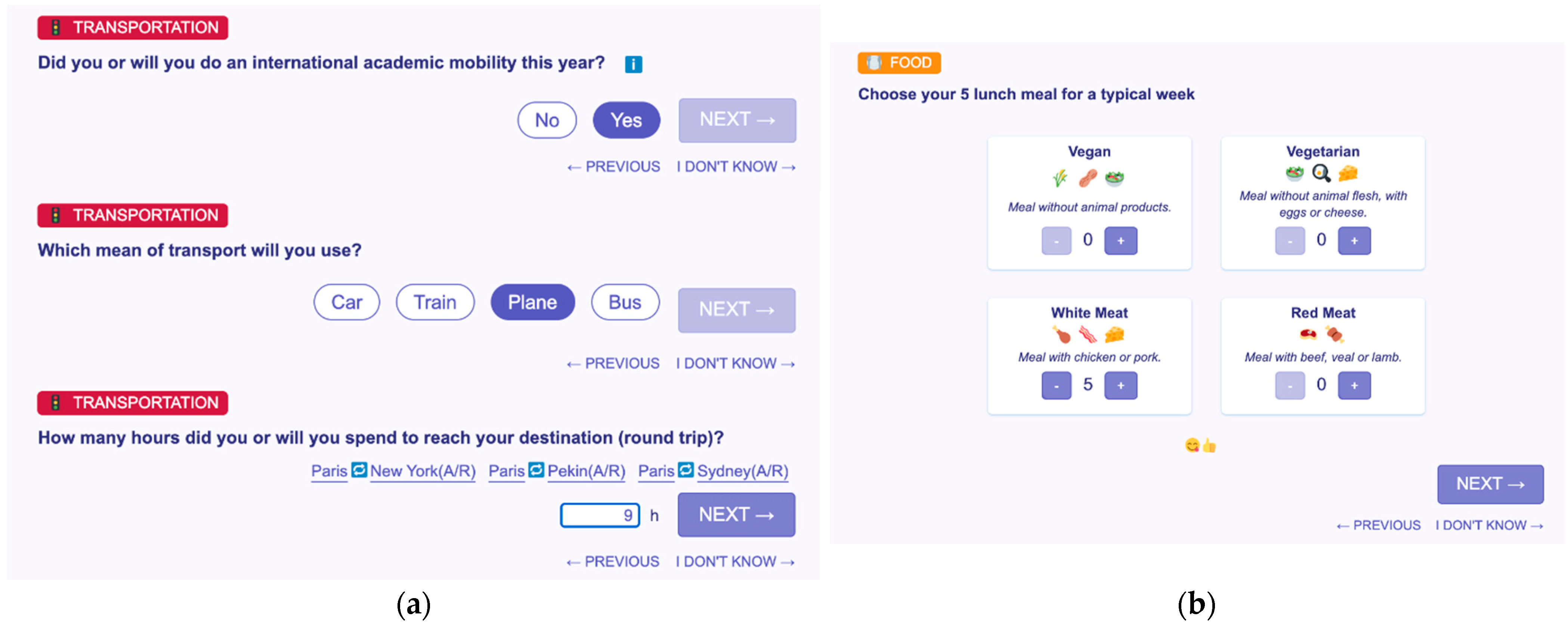Open-Source Carbon Footprint Estimator: Development and University Declination
Abstract
:1. Introduction
- Scope 1 includes direct emissions (fuel combustion, carbon sinks)
- Scope 2 covers indirect energy-related emissions (heating network, electricity)
- Scope 3 includes all the other indirect emissions (purchases of products and services, travel, food...). These emissions usually represent 80% of the GHG emissions of a company [9].
2. Methods
2.1. Source Version
2.1.1. A National Carbon Footprint Estimator
2.1.2. Technical Features
2.1.3. Advantages of the Tool for University Declination
2.2. Design of the University Declination
2.2.1. Carbon Footprint of Centrale Nantes
2.2.2. Restricted Perimeter and User Profiles
2.2.3. Simulation Saving Add-On
2.3. Tests Strategy
- Recruitment of the panel via emails and posts on social network
- Invitation on a messaging server
- First version of the simulator, one-week feedback period
- Correction of issues and implementation of new features
- Second version, two-week feedback period
- Focus-groups
- Correction of issues and implementation of new features
- Third version, two-week feedback period
- Deployment
3. Results and Discussion
3.1. National Version
3.2. Implementation of the University Declination
3.2.1. Initial User Profile-Related Questions
- Student and staff trips (2060 tCO2eq, 36% of the overall result)
- Products and Services (1200 tCO2eq, 21%)
- Students and staff lunches (830 tCO2eq, 15%)
3.2.2. User-Specific Intermediate Questions
3.2.3. Typical Result and Advice on Reducing Carbon Emissions
4. Conclusions
- Professional carbon footprint estimators can be built to complement personal estimators. To do so, scopes and activities must be clearly identified and separated.
- User-specific questions depending on user category (e.g., student, professor, staff) help increasing the ergonomics and the tool adoption. These elements are expected to increase the tool efficiency in triggering behavioral evolutions towards more sustainable practices.
- Offering quantified advice to take action depending on the user’s habits is particularly relevant as it helps developing a deeper understanding of climate impacts and its relationships to the user professional and academic activities.
- Open-source code availability and multi-agent collaborations are key success factors in developing sustainability initiatives. It enables the approach outlined in this study to be replicated in other higher education institutions.
Author Contributions
Funding
Institutional Review Board Statement
Informed Consent Statement
Data Availability Statement
Acknowledgments
Conflicts of Interest
References
- Wiedmann, T.; Minx, J. A Definition of ‘Carbon Footprint’. Ecol. Econ. Res. Trends 2008, 1, 11. [Google Scholar]
- Mancini, M.S.; Galli, A.; Niccolucci, V.; Lin, D.; Bastianoni, S.; Wackernagel, M.; Marchettini, N. Ecological Footprint: Refining the Carbon Footprint Calculation. Ecol. Indic. 2016, 61, 390–403. [Google Scholar] [CrossRef]
- IPCC Global Warming of 1.5 °C. Available online: https://www.ipcc.ch/sr15/chapter/spm/ (accessed on 8 March 2021).
- Energy Transition for Green Growth Stratégie Nationale Bas Carbone [National Low-Carbon Strategy]. Available online: https://www.ecologie.gouv.fr/sites/default/files/SNBC_SPM_Eng_Final.pdf (accessed on 8 March 2021).
- Čuček, L.; Klemeš, J.J.; Kravanja, Z. A Review of Footprint Analysis Tools for Monitoring Impacts on Sustainability. J. Clean. Prod. 2012, 34, 9–20. [Google Scholar] [CrossRef]
- Kitzes, J.; Peller, A.; Goldfinger, S.; Wackernagel, M. Current Methods for Calculating National Ecological Footprint Accounts. Sci. Environ. Sustain. Soc. 2007, 4, 9. [Google Scholar]
- International Organization for Standardization (ISO) Greenhouse Gases (Standard No. 14064-1). Available online: https://www.iso.org/standard/66453.html (accessed on 12 March 2021).
- Association Bilan Carbone; ADEME (The French Environment and Energy Management Agency) Methodology Guide—Version 8—Accounting Principles and Objectives. Available online: https://www.associationbilancarbone.fr/wp-content/uploads/2018/03/guide-methodologique-en-v2.pdf (accessed on 7 March 2021).
- Association Bilan Carbone; ADEME (The French Environment and Energy Management Agency) Réduire Les Émissions de Gaz à Effet de Serre Tout Au Long de La Chaîne de La Valeur de Votre Activité (Reduce Greenhouse Gas Emissions throughout the Value Chain of Your Activity). Available online: https://www.associationbilancarbone.fr/wp-content/uploads/2017/07/guide-pratique-scope-3.pdf (accessed on 12 March 2021).
- Robinson, O.; Kemp, S.; Williams, I. Carbon Management at Universities: A Reality Check. J. Clean. Prod. 2015, 106, 109–118. [Google Scholar] [CrossRef]
- Gifford, R. Psychology’s Essential Role in Alleviating the Impacts of Climate Change. Can. Psychol. Psychol. Can. 2008, 49, 273–280. [Google Scholar] [CrossRef]
- Carbone 4 Faire Sa Part? (Do Your Part?). Available online: http://www.carbone4.com/wp-content/uploads/2019/06/Publication-Carbone-4-Faire-sa-part-pouvoir-responsabilite-climat.pdf (accessed on 12 March 2021).
- Alvarez, S.; Blanquer, M.; Rubio, A. Carbon Footprint Using the Compound Method Based on Financial Accounts. The Case of the School of Forestry Engineering, Technical University of Madrid. J. Clean. Prod. 2014, 66, 224–232. [Google Scholar] [CrossRef]
- Yañez, P.; Sinha, A.; Vásquez, M. Carbon Footprint Estimation in a University Campus: Evaluation and Insights. Sustainability 2019, 12, 181. [Google Scholar] [CrossRef] [Green Version]
- Clabeaux, R.; Carbajales-Dale, M.; Ladner, D.; Walker, T. Assessing the Carbon Footprint of a University Campus Using a Life Cycle Assessment Approach. J. Clean. Prod. 2020, 273, 122600. [Google Scholar] [CrossRef]
- Larsen, H.N.; Pettersen, J.; Solli, C.; Hertwich, E.G. Investigating the Carbon Footprint of a University-The Case of NTNU. J. Clean. Prod. 2013, 48, 39–47. [Google Scholar] [CrossRef]
- Gómez, N.; Cadarso, M.-Á.; Monsalve, F. Carbon Footprint of a University in a Multiregional Model: The Case of the University of Castilla-La Mancha. J. Clean. Prod. 2016, 138, 119–130. [Google Scholar] [CrossRef]
- Bekaroo, G.; Bokhoree, C.; Ramsamy, P.; Moedeen, W. Investigating Personal Carbon Emissions of Employees of Higher Education Institutions: Insights from Mauritius. J. Clean. Prod. 2019, 209, 581–594. [Google Scholar] [CrossRef]
- Robinson, O.J. Towards a Universal Carbon Footprint Standard: A Case Study of Carbon Management at Universities. J. Clean. Prod. 2018, 172, 4435–4455. [Google Scholar] [CrossRef]
- Dolf, M.; Teehan, P. Reducing the Carbon Footprint of Spectator and Team Travel at the University of British Columbia’s Varsity Sports Events. Sport Manag. Rev. 2015, 18, 244–255. [Google Scholar] [CrossRef]
- Lambrechts, W.; Van Liedekerke, L. Using Ecological Footprint Analysis in Higher Education: Campus Operations, Policy Development and Educational Purposes. Ecol. Indic. 2014, 45, 402–406. [Google Scholar] [CrossRef] [Green Version]
- Townsend, J.; Barrett, J. Exploring the Applications of Carbon Footprinting towards Sustainability at a UK University: Reporting and Decision Making. J. Clean. Prod. 2015, 107, 164–176. [Google Scholar] [CrossRef]
- Lozano, R.; Young, W. Assessing Sustainability in University Curricula: Exploring the Influence of Student Numbers and Course Credits. J. Clean. Prod. 2013, 49, 134–141. [Google Scholar] [CrossRef]
- Lin, S. Identify Predictors of University Students’ Continuance Intention to Use Online Carbon Footprint Calculator. Behav. Inf. Technol. 2017, 36, 294–311. [Google Scholar] [CrossRef]
- Edstrand, E. Making the Invisible Visible: How Students Make Use of Carbon Footprint Calculator in Environmental Education. Learn. Media Technol. 2016, 41, 416–436. [Google Scholar] [CrossRef]
- Datagir; Association Bilan Carbone “Nos GEStes Climat” Calculator. Available online: https://nosgestesclimat.fr (accessed on 1 April 2021).
- Li, X.; Tan, H.; Rackes, A. Carbon Footprint Analysis of Student Behavior for a Sustainable University Campus in China. J. Clean. Prod. 2015, 106, 97–108. [Google Scholar] [CrossRef]
- Chao, Y.-L. Predicting People’s Environmental Behaviour: Theory of Planned Behaviour and Model of Responsible Environmental Behaviour. Environ. Educ. Res. 2012, 18, 437–461. [Google Scholar] [CrossRef]
- Mallett, R.K.; Melchiori, K.J.; Strickroth, T. Self-Confrontation via a Carbon Footprint Calculator Increases Guilt and Support for a Proenvironmental Group. Ecopsychology 2013, 5, 9–16. [Google Scholar] [CrossRef]
- Mulrow, J.; Machaj, K.; Deanes, J.; Derrible, S. The State of Carbon Footprint Calculators: An Evaluation of Calculator Design and User Interaction Features. Sustain. Prod. Consum. 2019, 18, 33–40. [Google Scholar] [CrossRef]
- ADEME (The French Environment and Energy Management Agency) Resource Centre for Greenhouse Gas Accounting. Available online: https://www.bilans-ges.ademe.fr/en/ (accessed on 8 March 2021).
- Clim’Foot Clim’Foot Database. Available online: https://www.climfoot-project.eu/en/overview-0 (accessed on 12 March 2021).
- Beta.gouv.fr Futur.Eco (GitHub Repository). Available online: https://github.com/laem/futureco (accessed on 1 April 2021).
- Beta.gouv.fr Mon-Entreprise.Fr (GitHub Repository). Available online: https://github.com/betagouv/mon-entreprise (accessed on 1 April 2021).
- Datagir Nosgestesclimat-Site (GitHub Repository). Available online: https://github.com/datagir/nosgestesclimat-site (accessed on 1 April 2021).
- Datagir Nosgestesclimat (GitHub Repository). Available online: https://github.com/datagir/nosgestesclimat (accessed on 1 April 2021).
- Ecole Centrale Nantes; Auger, C. Nosgestesclimat-Site-ECN (GitHub Repository). Available online: https://github.com/SustainabilityCN/nosgestesclimat-site-ECN (accessed on 1 April 2021).
- Ecole Centrale Nantes; Auger, C. Nosgestesclimat-Model-ECN (GitHub Repository). Available online: https://github.com/SustainabilityCN/nosgestesclimat-model-ECN (accessed on 1 April 2021).
- Energy Transition for Green Growth L’empreinte Carbone Des Français Reste Stable (The Carbon Footprint of the French Remains Stable). Available online: https://www.statistiques.developpement-durable.gouv.fr/sites/default/files/2020-01/datalab-essentiel-204-l-empreinte-carbone-des-francais-reste-%20stable-janvier2020.pdf (accessed on 12 March 2021).
- Mariette, J.; Blanchard, O.; Berné, O.; Ben-Ari, T. An Open-Source Tool to Assess the Carbon Footprint of Research. Sci. Commun. Educ. 2021. [Google Scholar] [CrossRef]
- The Shift Project “LEAN ICT”-Towars Digital Sobriety. Available online: https://theshiftproject.org/wp-content/uploads/2019/03/Lean-ICT-Report_The-Shift-Project_2019.pdf (accessed on 7 March 2021).
- Greenspector; Derudder, K. L’impact Environnemental Des Moteurs de Recherches. Available online: https://greenspector.com/fr/moteurs-de-recherches/ (accessed on 7 March 2021).
- Greenspector; Leboucq, T. Quelle Application Mobile de Visioconférence Pour Réduire Votre Impact? Available online: https://greenspector.com/fr/quelle-application-mobile-de-visioconference-pour-reduire-votre-impact/ (accessed on 7 March 2021).
- Ecole Centrale Nantes. Centrale Nantes “Nos GEStes Climat” Calculator. Available online: https://ngc-ecn.netlify.app (accessed on 1 April 2021).











Publisher’s Note: MDPI stays neutral with regard to jurisdictional claims in published maps and institutional affiliations. |
© 2021 by the authors. Licensee MDPI, Basel, Switzerland. This article is an open access article distributed under the terms and conditions of the Creative Commons Attribution (CC BY) license (https://creativecommons.org/licenses/by/4.0/).
Share and Cite
Auger, C.; Hilloulin, B.; Boisserie, B.; Thomas, M.; Guignard, Q.; Rozière, E. Open-Source Carbon Footprint Estimator: Development and University Declination. Sustainability 2021, 13, 4315. https://doi.org/10.3390/su13084315
Auger C, Hilloulin B, Boisserie B, Thomas M, Guignard Q, Rozière E. Open-Source Carbon Footprint Estimator: Development and University Declination. Sustainability. 2021; 13(8):4315. https://doi.org/10.3390/su13084315
Chicago/Turabian StyleAuger, Clément, Benoit Hilloulin, Benjamin Boisserie, Maël Thomas, Quentin Guignard, and Emmanuel Rozière. 2021. "Open-Source Carbon Footprint Estimator: Development and University Declination" Sustainability 13, no. 8: 4315. https://doi.org/10.3390/su13084315
APA StyleAuger, C., Hilloulin, B., Boisserie, B., Thomas, M., Guignard, Q., & Rozière, E. (2021). Open-Source Carbon Footprint Estimator: Development and University Declination. Sustainability, 13(8), 4315. https://doi.org/10.3390/su13084315





